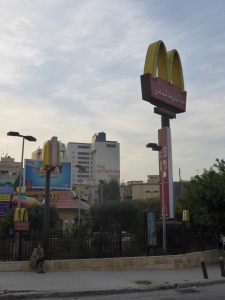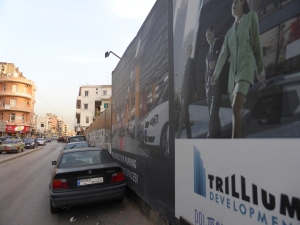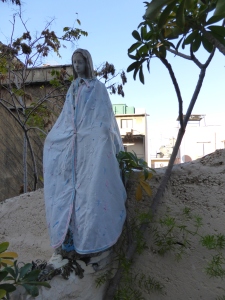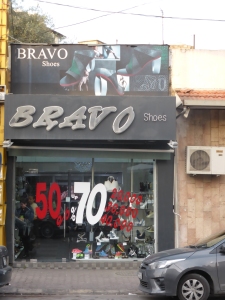Living in Furn el Chebbak
When I first came to Lebanon, I quickly found myself living in the neighbourhood of Furn el Chebbak. In time, it made sense: Beirut is an expensive city, and this neighbourhood was in its periphery (or at least I thought it was. I remember the first time I went there. Before that moment, I had only been in the rich – or richer – areas of Achrafieh and Hamra, and Furn el Chebbak looked to me at first sight like a poor and uninteresting neighbourhood. And, as it turns out, it sort of is: there are few restaurants, no bars, and little economic activity would it be for some shops and shopping centres. Compared to Sassine – where I previously lived for a week – Furn el Chebbak was a shock and, even though I would later see much more popular and poor neighbourhoods, probably our first experience of the Beirut tourists don’t see, simply because there is only life to be seen, and life is extraordinarily boring to tourists.
Situating the neighbourhood is not too hard: it is located in the southern part of the city, at the east of the hippodrome and, more importantly, surrounding Damascus street. When you go down that axis which goes from Sodeco Square to – precisely – Furn el Chebbak, you pass the French Embassy, the neighbourhood of Badaro, and the McDonalds to arrive to the neighbourhood itself. But I’ll get there.
Despite its very clear location in our mind and in that of other Beirut inhabitants, we were with my flatmates in the position of those for whom the street is both very close and incredibly distant. We didn’t know of the life in Beirut, yet alone the urban life and the dense practice of the neighbourhood this city knows. As everyone, though, we had quickly integrated the everyday routine of places that marks it, by walking and going to specific locations and establishments, mostly shops and leisure places – although these were never located in our living space. But we felt that lack of understanding of the space of our own neighbourhood. Of course, not speaking Arabic very well was hampering us. With Alexis, who was then my flatmate, we developed a little game after dinner: we would go in the streets and, randomly, pick a direction by taking turns. By doing so, we figured we would discover this space a little better, but to be honest we kept on seeing only the same thing. Empty streets followed empty streets, anonymous shops and walkers after the other. We watched, but we didn’t see, and we didn’t get any meaning out of it. After the short time this game lasted, we found ourselves in as much knowledge of the neighbourhood as we had when we started, that is absolutely none. So, we abandoned this enterprise and Alexis got back to his country.
After a year of living in the city, I “knew” Beirut a bit more. Yet coming back to Furn el Chebbak, where I live once more, I realised that I was still oblivious to the neighbourhood when Ifpo – the French Institute in the Near East – organised recently a seminar based on a research led on Furn el Chebbak two years ago. Its identity, history, and the perceptions of its inhabitants were unknown to me, and it got me thinking to what knowledge I had of my own space of living. Of course I did only approach Furn el Chebbak as I practice space, and still much information, stories and ideas about how people do live in Beirut can be entangled in this very mundane practice that I have. Yet those are difficult to present, would it only be because the risk is great to fall into an enchanted vision of the neighbourhood. Over-interpretation is always the risk, and the quantity of surprised reports written by expatriate workers or tourists shows it regularly: the visitor is surprised of the life of people, of their practice and expressions, and tends to show as a marvellous reality what he would see if he had the same look at his own place of origin.
And yet the city of Beirut is an occasion of looking at many of the elements that compose the Lebanese society, and to stop overlooking its complexity. Indeed the newcomer in the city will always have clichés thrown at him beforehand. For instance, my recently-acquired flatmate asked me before coming if there was any danger of living in Furn el Chebbak, since it was in the southern districts of the city. Of course, by “southern districts”, he meant the municipality of Ghobeyri, and the neighbourhoods of Dahieh and Burj al-Barajneh, which are marked by the strong presence of Hizbullah, and that foreigners are recommended to avoid, despite their absolute lack of originality in comparison to the rest of Beirut. Yet, even if it is indeed “south”, Furn el Chebbak belongs to a completely different part of the city. In the same fashion the distinction between “eastern” and “western” Beirut is valid, but regularly seen as a unique element, while it is possible to notice that people living in Hamra or in Barbir, both located in “western” Beirut, have very different landscapes, probably belong to different social groups, and rely on different professions. It is the same between Achrafieh and Furn el Chebbak, one of which is identified as a classy, modern, and rich neighbourhood, and the other as a poor, popular and “boring” one. This can lead to some people from Achrafieh to refuse or have a very hard time coming in Furn el Chebbak, which they would see as a disenfranchised and dangerous “banlieue”.
The mighty quest for the old café
So I decided to impose a little exercise on me. It all started in this seminar, where a discussion occurred on the origins of the name of Furn el Chebbak. In Arabic the word “furn” designates an oven, more specifically a bread oven, and by extension, a baker. In Lebanon a “furn” is a somehow local store where one can purchase bread, crackers and, more importantly, cheap oven-baked pizzas called manakish. While I ignore if the furn is socially important, as the general store is, it is certainly a place I do visit every other day at least. One could see why a neighbourhood would be named after a furn, if it is important enough. But the word “chebbak” comes from the Arabic “chubbak” which means window. Thus the neighbourhood’s name is “the oven of the window”, which is intriguing. One of the persons present, an architect, said that the neighbourhood took its name from a very famous furn in which people came after going down from the tramway, when there was a tramway in Beirut, and was located close to a very old café adequately called “the line end café”. I decided to go on a quest for this establishment.
It all started at the bottom of my building, or, to be accurate, at the corner of my street. Furn el Chebbak, as you will see as you read through, is by definition a neighbourhood, and how a person like me interacts with this space shows how we are not talking here about a mere division of space. As a practiced space and a lived space, Furn el Chebbak has its institution and its dominants: they are those who “qualify” the space, who are legitimate in giving it its definition and of moulding the legitimate representations of the inhabitants. And one of these institutions is, without a doubt, the general store, the dekken. A dekken is not, in Beirut, a mere provider of cheese and coffee. He is a semi-formal social institution, whose tasks are plenty. He is the repository for the memory of a part of the neighbourhood; he is also the holder of a place where rumours and stories are diffused. He is in some cases a business facilitator, who can put in contact the one who seeks a specific business and a trustworthy craftsman, or a person willing to rent and an owner willing to let. If Facebook and Craigslist have taken more space in that business, it is very common, when one looks for an apartment or a room, to use informal networks, among which your family, your friends and your dekken are going to be your first relays. So, I came to the dekken. Unfortunately I am a bit of an outsider to him: first I haven’t been living here for long and I am a foreigner, which qualifies me as a “newcomer”. But I do jibber-jabber Arabic, and I am French, so I am a somewhat nice person, or at least not an annoyance. This excuses my frequent “betrayals” committed by visiting the other dekken of the street, an act that has been a source of criticism for some of my flatmates.
But the point of my visit was clear: I was seeking the café of the line’s end. I hence started explaining my point to two most intrigued women holding the dekken. Much to my surprise, they had no idea what I was talking about and recommended me to go to nearby Badaro to have a drink. Badaro has indeed been recently “attacked” by bar owners and restaurants, much to the disarray of the old conservative bourgeoisie which is said to inhabit the place. My status of young, foreign student also plaid against me: why would I want to go to a maqha, while I can go to a bar or a franchised café (which, as franchised restaurants and shops, mostly American – some franchises that can hardly been found in France, such as Roadster Diner and Hardees, are present in Lebanon – are omnipresent in the city)? It is true that whatever traditional maqha I have been two had two varieties of clients: tourists, which are attracted by the “traditional” dimension of the place, and old male Lebanese people, generally going to the place for card or board games (and probably for gossip and idle talk, although they do spend a great deal of time yelling about the rules of the games), and smoking the arguileh. But the maqhas tourists go to in Beirut are definitely not in Furn el Chebbak, but in Raoucheh or in Downtown, on the sea front. I had to insist and to reformulate my request: being on an adventure for the origins of the neighbourhood, I was seeking the oldest establishment around. This had the advantage of making me sound like a moron, but a naïve and somewhat cute one. Thus, I was indicated a maqha, not bearing the name I was looking for, further down the street.
Four impressions
At this point of the story, four things happened: a sight, a smell, a place, and a shock. Or, to be more accurate, I entered Damascus Street, smelt incense, saw a little Virgin down the street, and startled at the sight of a veiled woman giving a phone call on the other side of the street. Such mundane elements, incredibly less impressive than what laymen usually see in Beirut (the tanks, the military, the traffic, the bullet impacts on the walls…) tell much more about the city.
Let’s begin with the beginning: the smell of incense. It annoys me, and I catch it at least once every three days when entering the elevator. It is not very good incense, but rather the type that makes you cough and want to puke. It burns the lungs and usually puts me immediately in a terrible mood. Once I caught a glimpse of the woman who burns this incense in our building’s shrine (because of course, there is a shrine). She was outside, her arm through the window, probably sure of how much good she was doing, while I was thinking about crushing her skull with a statue of the Virgin for trying to assassinate me by incense-poisoning. But in Furn el Chebbak it is unavoidable, there will always be someone to try to incensifiate your day. The common discourse is that Furn el Chebbak is a “Christian neighbourhood”. And, as it were, it is in a way, if you ignore an important share if its inhabitants who are not Christian at all. But the “old guard” of Furn el Chebbak have constructed an image of their neighbourhood as a Christian neighbourhood, as they have done in Ashrafiyeh, and they are very keen on reminding this aspect of their neighbourhood, by keeping many shrines in the buildings and in the streets, by incensifiating poor European sociologists, by graffiti and by “rites” in the street (such as signing oneself several times when passing a Virgin or a church, or entering the neighbourhood). Hence the little statue of the Virgin Mary, which has quickly become a part of my everyday landscape (as have the “There is no God but God and Muhammad is God’s Emissary” banners in Tariq el Jdideh and Borj al Barajneh): it is not as much the population, which is Christian, as it is the space itself which is invaded by religious and political symbols. But there is more to it than that: during the war, many neighbourhoods were “re-configured”, as the magnificent movie In this land lay graves of mine shows. The neighbourhood of Bourj Hammood, which is currently mostly inhabited by Armenians (and the only place, as far as I know, where butchers specialised in pork meat can be found) used, in the 1960s, to be inhabited massively by Shia Muslims which were attracted by this former refugee camp’s low rent prices. As for the Dahia, nowadays called the “Hizbullah quarter” by some blunt reporters, most of its parts did have an important Christian community before the war forced them to leave. But such was not the case in Furn el Chebbak, one of the historical fiefdoms of the Lebanese Forces which got protected as such. The “old guard” I mentioned refer to this period not as a “golden age”, but as the moment when they found out how much important it was to “protect their land”.
This is also why seeing this veiled woman on the telephone surprised me. Muslims, in Furn el Chebbak, have always been present as far as I knew. Not only to take low-paid jobs (when I lived there in 2010 the main street was reconstructed, by Syrian and Egyptian workers, as the furns were manned by Syrians, and so forth) but also by buyers and inhabitants. But it was badly seen. My friend F., who is from the Dahia and wears a chador, used to be looked at with extreme violence when strolling in Furn el Chebbak, and asked us to bring her to the taxi to avoid violence. This is not the case anymore. Of course what I say could be seen as a way to say that mean Christians are racist, I don’t believe this is the case. But, for the reason said earlier, many are afraid that the “rumour of the land” could hit them. This rumour, present in Lebanon apparently since ever, consists in saying that Muslim millionaires buy large patches of “Christian” land to make condominiums for other Muslims, and hence overwhelm the Christians in their own places. To what extent this is a fantasy and to what extent this is true is hard to determine, although the “conspiracy” aspect of the thing is a bit hard to buy, especially since the new buildings that grow in Furn el Chebbak (and would be owned by Shia Muslims) are still not inhabited. This is more, after the failure of “political Maronitism” and facing the wave of pro-federal discourses, the sign that the Christians, as a political community, are represented by people who play on their stress facing the future in a region in which their presence is threatened.
Damascus Street remains, which leads to another important element in this little bit of street corner where I was standing as I was feeling these four impressions. Going from Borj el Barakat (nowadays known as Beit Beirut) to the southern part of the city, Damascus Street follows what was “the green line” of Beirut, which separated the two conflictive parts of the city, except in Furn el Chebbak, which surrounds it. Nowadays, it is a commercial axis, in this specific part of the city, where two types of businesses are struggling: traditional dekkens, cheap clothes shops (on sale 365 days per year), translation businesses and furns are still holding their ground facing the arrival of bugger brands, although I don’t have a clue for how long. When I lived here in 2010, there was not a restaurant, only small snacks, and the biggest businesses, except for the McDonalds which guards the entrance of the neighbourhood without entering it, were Hawa Chicken and Fahed, respectively a relatively cheap fast-food brand and a local (relatively) cheap supermarket, which is regularly denounced to me by the “old guard” (my dekken literally applauded when I told him I refused to buy meat in Fahed and preferred butcher shops). The fact is, that Furn el Chebbak is slowly getting gentrified, and there is not much the “old guard” can do about it.
That’s the moment when I turned left, towards my next adventure.




useful article, thank you. I identified with everything you wrote. I am not sure if i am part of the gentrification process you mentioned, i recently acquired an old traditional house in furn el chebbak and it is quite a hasstle to register the titles at the registry ” i think it is due to the fact that i am muslim” , it is unconstitutional but what is in this country. Do you have some more details about the history of furn el chebbak?
Hello!
Unfortunately, no, I do not.
Accidentally found your blog, and am loving reading it!
Where can I find what happens when you “turned left”? (part 2)
Did you find the “café at the end of the line”?
Did you find the original “furn”?
Hello Ana,
Nice to see there are still people coming here after all this time! I wrote this in 2015 and closed the blog shortly after, thus the story of this small archeological investigation was lost… but I can recompose my memory now and give this tale an end. Stay tuned, maybe a post will pop up in the coming weeks.